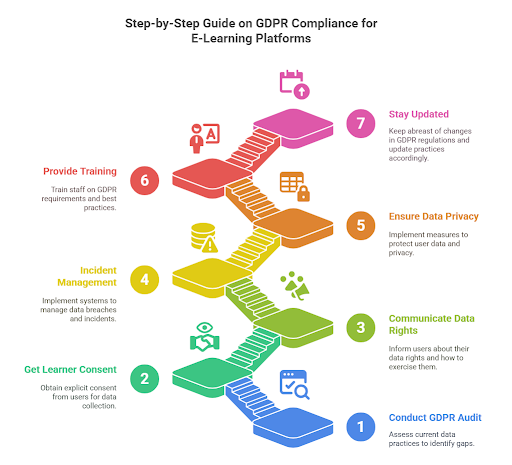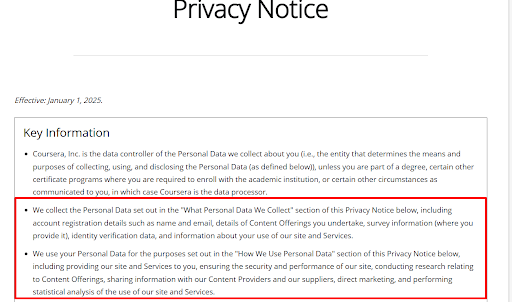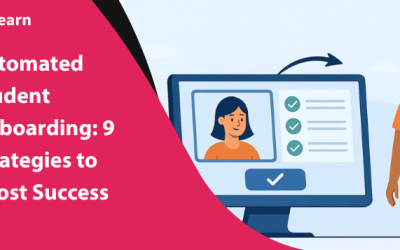7 Step Easy Guide for GDPR Compliance in E-Learning Platforms
Data security is an essential component in today’s educational landscape. With e-learning growth catalyzed by technology, the risk of exposing data is higher than ever. Regulatory laws, such as the Family Educational Rights and Privacy Act (FERPA) and the General Data Protection Regulation (GDPR), have been established over the years.
However, there is considerable ambiguity on adherence to their regulatory requirements. You need to manage user consent, technical safeguards, and security measures.
In this blog, we’ll be shedding light on GDPR compliance for e-learning platforms. From the basic definition to how to become GDPR-compliant and challenges, here’s everything you need to know!
What is GDPR?
General Data Protection Regulation (GDPR) is the most powerful privacy law in the world. The law aims to protect privacy of EU users by regulating how organizations collect, use, store and share data. The law applies to EU organizations and those handling EU customer data.
The GDPR was implemented from May 25th, 2018. GDPR has eight fundamental data principles, along with the right to withdraw consent.
The eight GDPR laws are related to:
- Information
- Access
- Rectification
- Erasure
- Data portability
- Restrict data processing
- Withdraw consent
- Right to Object
The primary goal is to provide users with more freedom over their personal information and its use. So, organizations are required to obtain explicit user consent before collecting data. Besides, they should explain the why and how of user data collection.
Above all, users have the right to access, modify and delete the data at any time.
How Does GDPR Apply to Online Learning?
The GDPR applies to e-learning and LMS platforms as they process large amounts of user data. The common forms of data include names, emails, IP addresses, dates of birth, and social media profiles. Additionally, users also share payment information, such as credit card numbers and digital wallets.
Any organization handling personal data should adhere to GDPR laws. So, whether it’s an online course business or a tutoring marketplace, GDPR compliance is crucial.
Now, this is applicable even if you are an educator and run your personal business. Here, you’re the data collector. You also need to provide a logical reason for data collection. This could involve consent, contracts, or interests to enhance your services.
For example, you own a course subscription business like Coursera. Learners get access to unlimited courses at a fixed monthly fee. Here, even though the user opts for automated renewals, user consent is important. You can send a consent confirmation mail before the renewal period.
7-Step Checklist to Become GDPR-compliant
GDPR is an invisible armor that protects your business from privacy concerns. Better late than never!
That said, let’s take a closer look at the key steps to become GDPR-compliant:

Step 1: Conduct GDPR Audit
First, identify where your e-learning platform stands. Conduct a thorough compliance audit to identify areas for improvement and implement necessary adjustments.
Here are the potential aspects you shouldn’t overlook in an audit:
-
Personal Data Collection
What kind of data do you collect? Only LMS-related data or even website interactions? Ensure you collect only minimal learner data necessary.
-
Third-Party Integrations
To scale your e-learning platforms, third-party integrations are essential. This could be a third-party tool, such as Zoom, Stripe, or an LMS. Ensure the DPA protects against data breaches and identity theft.
-
Privacy Policy
Is your privacy policy up-to-date with GDPR? Create a clear, transparent and accessible policy for all users. For instance, it should clearly state how personal data is collected, stored, and used, along with its intended purpose. Other aspects include user rights and data security.
-
Security Measures
Data security is a core principle of GDPR. Ensure the collected data is secure and protected from unauthorized access. Two-factor authentication, role-based access, and data backups are a few common security measures.
-
Managing Data Request
Users have the right to access, modify, and delete their personal data. Ensure you communicate the same to them. Also, you have procedures for access requests, rectification, data processing, and even objections to marketing.
-
Data Retention Policy
Data retention is as important as data usage. Your e-learning platform must outline how far user data is retained.
-
Cookie Compliance
Enable users to accept or reject cookie consent. Besides, offer access to the information like cookies used, purpose, and third-party access.
Step 2: Get Consent From Learners & Site Visitors
A website needs explicit consent to collect personal data from users.
So, your privacy policy should include the purpose of personal data and how you’ll be using it.
Use an opt-in form to confirm their consent for data processing. Include a terms and conditions link in the form. Thus, learners can make a quick reference on how their data would be handled.
Consent is also essential for cookies on your website. Add a cookie banner with policy and option to accept or decline consent.
Lastly, opt-out or provisions to revoke user consent is crucial.

Step 3: Communicate Data Rights to Users
Communicating data rights to users is a key principle of GPR compliance.
GDPR offers users specific rights: request (data portability), access, deletion (right to deletion), and modification.
To handle data requests, implement an automated portal on your website. Here, learners can request a digital copy of their personal data. They can receive it within a timeline of one month free of charge.
Here are different ways for communicating data rights to users:
- Privacy policy
- Onboarding/ Registration Flow
- Help Center
- Consent forms or pop-ups
Above all, the data request must be easy to fill and submit.
Step 4: Provide Incident Management & Content Breach Systems
Managing a data breach is one of the toughest challenges. But you cannot neglect it as your data is at risk.
So, when does a data breach happen? Unauthorized access, accidental data sharing, or poor access control can cause data breaches.
For instance, your website server is compromised. The hacker gains access to all the information, including names, credit card details, and emails.
Now, this requires immediate action!
Here’s a detailed action plan you can follow:
-
Detection
The first step is to detect the incident and limit the data loss. Monitor any unusual activity (spike in traffic, consistent login attempts, etc)
-
Determining the scope
Assess the extent of damage and data loss. For instance, the data that has been compromised. Evaluate the extent to which it has impacted users and organizations.
-
Isolation
To prevent further damage, isolate or disconnect the affected system from the network.
-
Reporting the breach
As per Article 33 GDPR, report the incident to the supervisory authority (Data Protection Officer) within 72 hours. Include the incident details, its impact and measures taken in the report. Also, failure to inform within the deadline could lead to penalties and legal consequences.
-
Fix the system and update the security
Fix the vulnerability and restore the data with backup. Lastly, conduct a post-audit breach and update the security loopholes in the system and policy.
Step 5: Ensure Data Privacy and Security
As technologies like AI evolve, security is at unprecedented risk. GDPR’s Privacy by design is intended to safeguard your platform against data breaches.
A privacy-first attitude ensures a proactive approach where security is taken care of right from the outset. For an e-learning platform, this means implementing privacy in system design, organizational processes and practices, protocols, and standards.
Some security measures to protect learners’ privacy are:
-
Strong Password & Two-factor authentication
Implement a strong password policy for accounts. For instance, mandate long and complex passwords and mix uppercase and lowercase characters and symbols. An additional mechanism like two-factor authentication makes your system impenetrable.
-
SSL Certificates
SSL certificates encrypt information between user and the server. Even if data is intercepted, it remains unreadable to a third party. This is useful for logging in and financial transactions, thereby avoiding data breaches.
-
SSO
SSO helps users to access multiple systems using a single credential. The technology could be used to access LMS as well. Better access control, user experience, and security are a few advantages of SSO.
-
Data Encryption
Encryption includes data protection in transit and at rest. HTTPS & SSL protocols encrypt data in transit. Ensure data stored in the server is not compromised. This takes care of encryption at rest.
-
Security Audits
Conduct regular security audits to identify and fix vulnerabilities. Include risk assessment, network security, and penetration testing as a part of these audits.
-
Regular Data Backups
Learner data is invaluable, and you can’t afford to lose it. Data backups are your useful hedge against system failures or security breaches.
-
Access Controls
An effective role of access management protects sensitive data. For instance, limiting instructors to course creation while the admin gets full control of the platform.
Step 6: Offer GDPR Training to Your Team
While GDPR compliance is crucial for your website, your instructors should be equally equipped.
To start with, instructors should know what data to collect and how to store it securely. Further, educate them about best email practices and information they shouldn’t share.
Train them with real-life scenarios to help handle data breaches better. For example, an educator sends a student’s assessment results to the wrong address. Here you could explain the best way to handle the situation.
Create comprehensive training including basic principles, instructor responsibilities & rights, and data breaches.
Offer training through live webinars, quick tutorials or reference guides. End it with a short quiz to understand how far they have grasped.
Step 7: Stay Updated with GDPR Compliance Changes
Lastly, ensure you stay updated with the changes in GDPR policy. Review your privacy policies to ensure they are in line with the changes. Also, you need to fine-tune your policies based on your findings and practical experiences with the platform.
Challenges to Becoming GDPR-Compliant
The path to becoming GDPR-compliant could be tedious. The challenge stems from the volume and complexity of data, as well as the need to prioritize accessibility and user experience in this process.
Challenge # 1: Sheer Volume and Diversity of Data
E-learning platforms store large volumes of essential data. From emails to voice recordings, their diversity makes them complex to manage. Also, managing them across third-party tools and integrations adds to complexity.
Solution: Use data discovery, categorization and mapping tools. This helps to identify new data and manage them effectively.
Challenge # 2: Consent Management
GDPR mandates an opt-in form for gathering user consent. While this is usually possible with forms, pop-ups, or opt-in checkboxes. Here, cookie categorization and storing user content are two prime problems.
Solution: Use third-party tools like Cookiebot and OneTrust to store, track, and manage cookies
Challenge # 3: Managing Third-Party Tools and Integrations
Using an e-learning platform often involves working with third-party tools. For instance, Zoom, Kahoot, and Stripe are often used to enrich the learning experience. Managing data processing agreements for these tools comes with challenges.
Solution: Choose software and tools that adhere to GDPR laws.
Challenge # 4: Handling Cross-Border Data Transfers
Cross-border data transfers are common in e-learning platforms. Countries around the world have different data processing laws. For instance, GDPR for the EU and CCPA for the US. Adherence to data protection laws in both source and destination countries is a real challenge.
Solution: Ensure “adequate decision” during data transfer. Alternatively, implement data encryption practices and seek legal advice.
Does GDPR Apply to Organizations Outside the EU?
Yes, GDPR might apply to organizations outside the EU.
If your platform collects and records personal data for EU citizens, the ‘territorial scope’ comes into play. However, when GDPR applies to organizations processing data related to EU citizens it is called extra-territorial scope.
For example, a US company might offer courses to EU learners. And the data might be hosted in Singapore-based cloud storage. But, it must comply with the GDPR laws.
Key Takeaways
Let’s summarize the key points we have understood so far!
- GDPR is directed to defend the privacy of EU citizens and residents. The law mandates that organizations define how personal data is collected, used, and protected.
- GDPR requires an opt-in model for implementing consent management.
- Organizations must have a clear and transparent privacy policy to communicate user rights. Users can request personal data and have it deleted or modified.
- Having a robust incident management system helps manage data breaches more effectively.
- Technology and security safeguards prevent security breaches “by design” and “by default.” Strong passwords, two-factor authentication (2FA), role-based access, single sign-on (SSO), etc., are few examples.
- Provide basic GDPR training to instructors to enhance their data handling and security practices.
- For cross-border data transfers, ensure GDPR compliance at the source and destination.
⚖️ Important Reads:
FAQ-Related to GDPR Compliance for eLearning Platforms
1. What are the 4 rules of GDPR?
The four important principles GDPR enforces to follow are:
- Lawfulness, fairness, and transparency
- Purpose limitation
- Data Minimization
- Accuracy
2. Does GDPR apply to e-learning?
Yes, GDPR applies to e-learning platforms. EU-based platforms or those processing the personal user data of EU residents fall under the law’s scope.
3. Do I need student consent for recording a lesson?
Yes, you need student consent for recording their lesson. You need to inform them why it’s recorded, how it will be used, and for how long it will be stored.
4. What should I do if I accidentally share student information with the wrong person?
If you accidentally shared student information with the wrong person, this is a confidentiality breach. Immediately report to the data protection officer or concerned supervisor. If the data is available in the public domain, remove it immediately. Lastly, implement safeguards to avoid future breaches.





